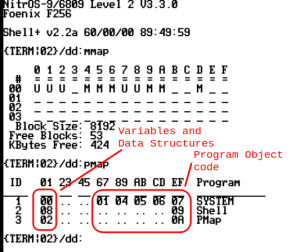OS-9 Assembly Code Development: Difference between revisions
| Line 119: | Line 119: | ||
<code> mod eom,name,tylg,atrv,start,size</code> | <code> mod eom,name,tylg,atrv,start,size</code> | ||
</code> | </code> | ||
<code> [Variables | <code> [Variables Here]</code> | ||
</code> | </code> | ||
<code>size equ .</code> | <code>size equ .</code> | ||
Revision as of 13:51, 29 September 2024
Overview
Each process in NitrOS-9 is allocated its own 64K address space. When run, the program object code is loaded into the end of the memory space, and the variables and data structures are loaded into the beginning. In addition, NitrOS-9 keeps an separate per-process MMU table (DAT Image), so you must use F$MapBlk to map and F$ClrBlk to unmap 8K blocks in your process' address space. The operating system has its own 64K address space as well.
When a new process is created, registers U, Y, DP and SP are set with U = start of data area, Y = end of data area, DP = page # of beginning page, SP = end of data area + 1. Each process includes its own execution and data directories, along with std in, std out and std err.
Memory and DAT Image
mmap and pmap output the current status of the memory in the system. mmap shows which memory blocks are currently in use. pmap shows the blocks that are mapped in the DAT Image for a particular process.

Program and Data Module Structure
There are 9 different types of modules in 4 possible languages:
| Module Types | Language | ||||
|---|---|---|---|---|---|
| Code | Module Type | Name | Code | Language | |
| $1x | Program Module | Prgm | $x0 | Data (non-executable) | |
| $2x | Subroutine Module | Sbrtn | $x1 | 6809 Object Code | |
| $3x | Multi-module | Multi | $x2 | BASIC09 I-Code | |
| $4x | Data Module | Data | $x3 | PASCAL I-Code | |
| $5x-$Bx | User-definable module | $x4-$xF | Reserved for Future Use | ||
| $Cx | OS-9 System Module | Systm | |||
| $Dx | OS-9 File Manager Module | FlMgr | |||
| $Ex | OS-9 Device Driver Module | Drivr | |||
| $Fx | OS-9 Device Descriptor Module | Devic | |||
The two most used will be Program Modules and Data Modules.
Program Modules
The format of the program module varies depending on whether you have a single source file for your program or multiple source files.
Note: multiple source files format cannot use direct page addressing due to the way they are compiled.
Single Source File Format
********************************************************************* [Program Name]* [Description]** by [Author Name]** Edt/Rev YYYY/MM/DD Modified by* Comment* ------------------------------------------------------------------nam [executablename]ttl [Full Program Name]ifp1use defsfileendctylg set Prgrm+Objctatrv set ReEnt+revrev set $00edition set 1mod eom,name,tylg,atrv,start,size[Variables Here]size equ .name fcs /executablename/fcb editionstart[Program Code Here]os9 F$Exitemodeom equ *end
Multiple Source File Format
Data Modules
Here is a portion of the font module, which is a data module in NitrOS-9.
nam font
ttl F256 font
use defsfile
tylg set Data
atrv set ReEnt+rev
rev set $01
mod eom,name,tylg,atrv,start,0
name fcs /font/
start
L0000 fcb $00,$00,$00,$00,$00,$00,$00,$00
L0008 fcb $7C,$82,$AA,$82,$BA,$92,$82,$7C
*More data here
emod
eom equ *
end
Writing Position Independent Code
All code in NitrOS-9 must be position independent. Addresses are not known until a program module is loaded and executed. All addressing must be "program counter relative addressing". All branch and long branch instructions are program counter relative.
Rules:
Use BRA and LBRA instead of JMP
Use BSR and LBSR instead of JSR
Use program counter relative indexed addressing for all load, store, arithmetic and logical instructions.